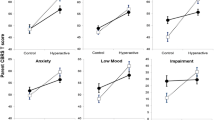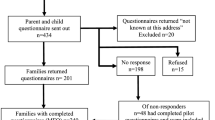Abstract
Purpose
Childhood hyperactivity leads to mental health problems, but it is not known whether there are long-term risks for adult mood problems in unselected population cohorts that extend to mid-life. Aims were to examine links between childhood hyperactivity and mood problems up to age 50 years and to consider confounding factors and gender differences in associations.
Methods
The National Child Development Study (NCDS) is a UK cohort of children born in 1958. Children with (N = 453) and without (N = 9192) pervasive and persistent hyperactivity were followed to age 50. Adult mood was assessed using the Malaise Inventory at ages 23, 33, 42, and 50 years and the CIS-R interview at 45 years.
Results
Childhood hyperactivity predicted low mood at all adult assessments (ES = 0.27–0.45), including after covariate adjustment (childhood adversity, emotional and behavioural problems, and attainment).
Conclusion
Hyperactivity has enduring risk effects on low mood throughout the life course that extend to middle age.
Similar content being viewed by others
References
Thapar A, Cooper M (2016) Attention deficit hyperactivity disorder. Lancet 387:1240–1250
Thapar A, Cooper M, Jefferies R, Stergiakouli E (2012) What causes attention deficit hyperactivity disorder? Arch Dis Child 97:260–265
Cherkasova M, Sulla EM, Dalena KL, Pondé MP, Hechtman L (2013) Developmental course of attention deficit hyperactivity disorder and its predictors. J Can Acad Child Adolesc Psychiatry 22:47–54
Wilens TE, Biederman J, Spencer TJ (2002) Attention deficit/hyperactivity disorder across the lifespan. Annu Rev Med 53:113–131
Polanczyk GV, Willcott EG, Salum GA, Kieling C, Rohde LA (2014) ADHD prevalence estimates across three decades: an updated systematic review and meta-regression analysis. Int J Epidemiol 43:434–442
Antshel KM, Hargrave TM, Simonescu M, Kaul P, Hendricks K, Faraone SV (2011) Advances in understanding and treating ADHD. BMC Med 9:72
Klein RG, Mannuzza S, Olazagasti MA, Roizen E, Hutchison JA, Lashua EC, Castellanos FX (2012) Clinical and functional outcome of childhood attention-deficit/hyperactivity disorder 33 years later. Arch Gen Psychiatry 69:1295–1303
Langley K, Fowler T, Ford T, Thapar AK, van den Bree M, Harold G, Owen MJ, O’Donovan MC, Thapar A (2010) Adolescent clinical outcomes for young people with attention-deficit hyperactivity disorder. Br J Psychiatry 196:235–240
Biederman J, Monuteaux MC, Mick E, Spencer T, Wilens TE, Silva JM, Snyder LE, Faraone SV (2006) Young adult outcome of attention deficit hyperactivity disorder: a controlled 10-year follow-up study. Psychol Med 36:167–179
Bussing R, Mason DM, Bell L, Porter P, Garvan C (2010) Adolescent outcomes of childhood attention-deficit/hyperactivity disorder in a diverse community sample. J Am Acad Child Adolesc Psychiatry 49:595–605
Shaw M, Hodgkins P, Caci H, Young S, Kahle J, Woods AG, Arnold LE (2012) A systematic review and analysis of long-term outcomes in attention deficit hyperactivity disorder: effects of treatment and non-treatment. BMC Med 10:99
Able SL, Johnston JA, Adler LA, Swindle RW (2007) Functional and psychosocial impairment in adults with undiagnosed ADHD. Psychol Med 37:97–107
Thapar A, Collishaw S, Pine DS, Thapar AK (2012) Depression in adolescence. Lancet 379:1056–1067
Power C, Elliott J (2006) Cohort profile: 1958 British birth cohort (National Child Development Study). Int J Epidemiol 35:34–41
Rutter M, Tizard J, Whitmore K (1970) Education, health and behaviour. Longman, Green, London
Rodgers B, Pickles A, Power C, Collishaw S, Maughan B (1999) Validity of the Malaise Inventory in general population samples. Soc Psychiatry Psychiatr Epidimiol 34:333–341
Takizawa R, Maughan B, Arsenault L (2014) Adult health outcomes of childhood bullying victimization: evidence from a five-decade longitudinal British birth cohort. Am J Psychiatry 171:777–784
Lewis G, Pelosi AJ, Araya R, Dunn G (1992) Measuring psychiatric disorder in the community: a standardized assessment for use by lay interviewers. Psychol Med 22:465–486
Das-Munschi J, Clark C, Dewey ME, Leavey G, Stansfeld SA, Prince MJ (2013) Does childhood adversity account for poorer mental health and physical health in second-generation Irish people living in Britain? Birth cohort study from Britain (NCDS). BMJ Open 3:e001335
Maughan B, Collishaw S, Pickles A (1999) Mild mental retardation: psychosocial functioning in adulthood. Psychol Med 29:351–366
Maughan B, Collishaw S, Stringaris A (2013) Depression in childhood and adolescence. J Can Acad Child Adol Psychiatry 22:35–40
Rutter M, Kim-Cohen J, Maughan B (2006) Continuities and discontinuities in psychopathology between childhood and adult life. J Child Psychol Psychiatry 47:276–295
Stringaris A, Cohen P, Pine DS, Leibenluft E (2009) Adult outcomes of youth irritability: a 20 year prospective community-based study. Am J Psychiatry 166:1048–1054
Kupfer DJ, Frank E, Phillips MJ (2012) Major depressive disorder: new clinical, neurobiological, and treatment perspectives. Lancet 379:1045–1055
Dennerstein L, Soares CN (2008) The unique challenges of managing depression in mid-life women. World Psychiatry 7(3):137–142
Chang Z, D’Onofrio BM, Quinn PD, Lichtenstein P, Larsson H (2016) Medication for attention-deficit/hyperactivity disorder and risk for depression: a nationwide longitudinal cohort study. Biol Psychiatry. doi:10.1016/j.biopsych.2016.02.018
Sellers R, Maughan B, Pickles A, Thapar A, Collishaw S (2015) Trends in parent- and teacher-rated emotional, conduct and ADHD problems and their impact in prepubertal children in Great Britain: 1999–2008. J Child Psychol Psychiatry 56:49–57
Stergiakouli E, Martin J, Hamshere ML, Langley K, Evans DM, St Pourcain B et al (2015) Shared genetic influences between attention-deficit/hyperactivity disorder (ADHD) traits in children and clinical ADHD. J Am Acad Child Adolesc Psychiatry 54:322–327
Collishaw S, Maughan B, Pickles A (2004) Affective problems in adults with mild learning disability: the roles of social disadvantage and ill health. Br J Psychiatry 185:350–351
Young S, Murphy CM, Coghill D (2011) Avoiding the ‘twilight zone’: recommendations for the transition of services from adolescence to adulthood for young people with ADHD. BMC Psychiatry 11:174
Acknowledgments
The authors express their gratitude to the National Child Development Study participants, to the UK data archive for providing access to the anonymised data, and to Olga Eyre for comments on a previous draft of the paper.
Author information
Authors and Affiliations
Corresponding author
Ethics declarations
Ethical standards
The manuscript does not contain clinical studies or patient data.
Conflict of interest
On behalf of all authors, the corresponding author states that there is no conflict of interest.
Electronic supplementary material
Below is the link to the electronic supplementary material.
Rights and permissions
About this article
Cite this article
Stuart-Smith, J., Thapar, A., Maughan, B. et al. Childhood hyperactivity and mood problems at mid-life: evidence from a prospective birth cohort. Soc Psychiatry Psychiatr Epidemiol 52, 87–94 (2017). https://doi.org/10.1007/s00127-016-1285-5
Received:
Accepted:
Published:
Issue Date:
DOI: https://doi.org/10.1007/s00127-016-1285-5




